Compaction Process
A new method for the COMPACTION process in the production of concrete elements
Manufacture of railway sleepers of prestressed concrete using optimised compaction methods.
Normal railway sleepers - in Germany for example the type “B 70“ - and also crossing sleepers, are produced as prestressed and prefabricated concrete parts. The concrete which is poured into the sleeper moulds must be greatly compacted in order on the one hand to achieve the required strength and on the other to perfectly surround the reinforcement, which is in the form of pre-tensioned steel wires.
Fig. 1 shows a new production process which was first used in Spain and which is supremely able to fulfil the high requirements as regards compaction.
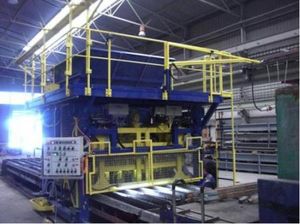
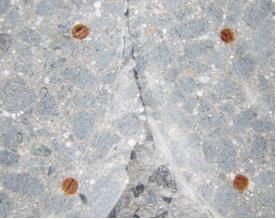
Two major factors provided the motivation for the development of a new type of compaction method:
- Reduction of the extremely high maintenance and replacement part costs, which occur based on the conventional compaction method – shock impact of the vibrating equipment against the floor of the mould or the bearer structure
- The very high noise pollution created by the manufacturing principle in use to date which is no longer tolerable because of increasingly strict regulations
The initial position
The manufacturing process which is always used for crossing sleepers and is often used for normal sleepers is the so-called "Long-Line" method. In this method, the moulds lie between the tension station and the abutment in a 80 to 140m long pretensioning bed.
The critical manufacturing step is the compaction of the concrete mass. The compaction method used to date consisted of pulling a steel slider with built-on external vibrators through parallel C profiles forming a part of the bearing frame of the mould equipment using a continuous cable. Within this process, the skids of the slider beat against the lower limbs of the C profiles in time with the vibration frequency - 50Hz to 70Hz. The side walls and the floor of the mould boxes, which are made of steel plate, are caused to vibrate mechanically, and this vibration is transferred to the concrete mass and compacts it.
The serious disadvantage of this method is that the entire bearing frame of steel profiles as well as the mould boxes start to vibrate at high frequency, which are overlaid by the beating of the skids. The huge surface emits airborne and structure-borne noise. During the vibration process, the noise level can reach 103.5 dBA.
The idea for a new, optimised compaction process
The mechanical vibration is not introduced into the concrete mass indirectly, as described in the previous paragraph - in other words via the diversion through the mould walls. In the new method they should rather be directly passed into the concrete from a "working part" which is submerged in the mass, functioning therefore in the manner of a vibrating head – but using high-performance external vibrators.
A series of trial, carried out in a methodical fashion - for which corresponding equipment was created - showed the basic "suitability" of this method (Fig. 2). In addition it was possible to gain sufficient knowledge to implement the oscillator/vibrator/tools/elastic bedding in such a way as to be efficient in practice.

Transfer of the idea to a machine design suitable for industrial use
Such a manufacturing process cannot be achieved with the known vibrating heads. The well-known system-related limitation of this design of vibrator - a very high operating rpm of 12000 1/min, in order to generate centrifugal force suitable for this application, as well as the associated need to disperse process heat – practically exclude the use of this internal vibrator. To this is added the fact that because of the size of these internal vibrators, it is not possible for them to submerge between the steel wires and the mould walls.
A special "oscillator" was developed, i.e. a base frame which accommodates an external electric vibrator on its upper side and which carries two "tools" on its underside, which are submerged in the concrete mass.
The oscillator is linked to the bearer frame by means of rubber buffers in such a way that the "tools" describe a circular vibratory movement in the form of an ellipse.
The machine construction
In this particular application six of these oscillators - operating independently of one another - are combined to form one construction unit. This construction unit consists of a frame, which can be moved vertically by means of a robust system of guides. This means that the "tools" can be submerged and removed at the start and end of the mould respectively. In addition, by means of a second guide device, the entire vibration unit can be moved horizontally, crossways to the moulds. This means that any sideways differences in the tracking position of the individual moulds can be compensated for, simply by "pressing a button".
In front of the compaction unit is located the concrete discharge unit, which works conventionally by means of screw conveyors. The concrete which is supplied from the bucket conveyor is fed into the silo which is built into the machine frame above the screw conveyors. Both main components – complete concrete discharge unit and compaction unit – are integrated into a compact machine frame, which is moved on rails on running and drive wheels by means of an electrically operated drive.
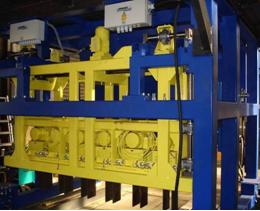
Use in production
The concrete feed into the moulds and the compaction unit work together perfectly in a perfectly harmonised sequence (Fig. 4). The machine is controlled on the one hand by means of the operating unit attached to the machine (Fig. 5) and - to achieve optimum freedom of movement for the operator – additionally with a cable remote control, which is also supplied with the main control function. This means that the operator is always in a position to intervene in the production process, depending on the situation. Using this process, it has been possible considerably to reduce the average cycle time for filling and compacting of a 6-fold mould in comparison with the original method.
What is also pleasing for those working in the production area is, above all, the fact that it has been possible to considerably reduce the noise level by using this production process. The reduction in the noise level from 103 dbA to approximately 87 dbA which has been achieved has received a very warm reception from the quarry employer's liability insurance association.
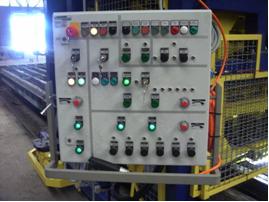
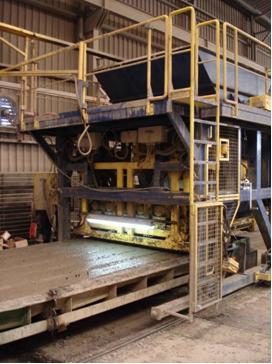
Teamwork
Development of a new kind of production process can only be achieved in close cooperation with an expert partner from the industry. The bundling of expertise on the one hand, the willingness to engage actively in such a project on the other hand, combined with sufficient determination, are indispensable prerequisites for the success of a project of this scale. The former "Infrastructure Technology" division of Pfleiderer AG, with its factories in Coswig as well as Travipos in Constanti in Spain, now integrated into the company Rail.One, took this road along with the company Knauer Engineering from Geretsried. While, in the Coswig factory, several successful trials were carried out to demonstrate the basic "feasibility" of this improved and "quiet" compaction method, implementation of the method in a process-capable production machine was carried out in the Spanish factory of Travipos S.A. Only through the active support of the partner company and its excellent know-how in the areas of process engineering and concrete technology was it possible to completely integrate the machine into the production process within a short time.
Prospects
After almost nine months of use and the experience gained from actually operating the machine, automation of some individual stages in the production process which are currently called up by the operator by hand is being considered. The aim is that the operator should only have to intervene in the process where his experience and trained eye are of decisive importance – all other tasks are carried out by the machine.
It is a logical step that this process is not only suitable for the production of concrete sleepers, but can be adapted to other similarly-shaped concrete components. Whether as a complete relocatable machine with corresponding peripherals or as a purely stationary compaction unit – the machine can be adapted to the individual application.
![[Translate to Englisch:] Ansprechpartner](/assets/content/dummy-ansprechpartner.png)
Contact person
For questions about the product range "Special machines", please contact
Peter Ortmann
08171 - 6295-24
E-Mail